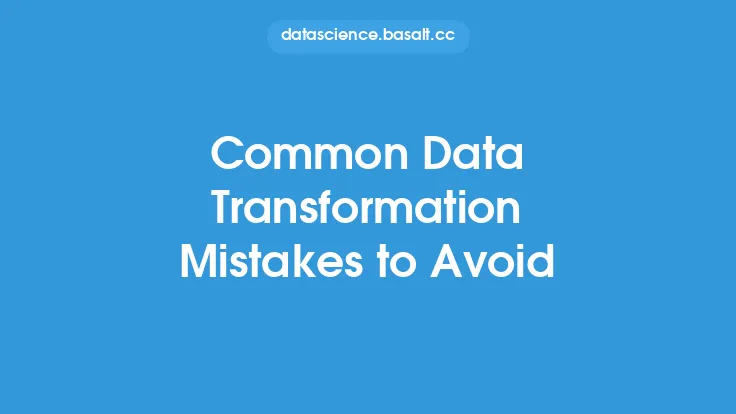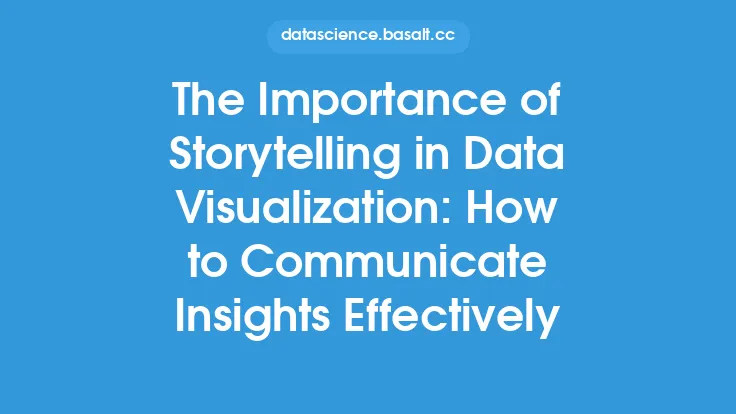When it comes to presenting data, visualization is a crucial aspect of effectively communicating insights and trends. However, there are several common mistakes that can lead to misleading or confusing visualizations, ultimately undermining the value of the data. To create informative and engaging data visualizations, it's essential to understand these pitfalls and learn how to avoid them.
Introduction to Data Visualization Mistakes
Data visualization is a powerful tool for presenting complex data in a clear and concise manner. However, when not done correctly, it can lead to misinterpretation of the data, which can have significant consequences in business, research, and other fields. Some of the most common mistakes in data visualization include using the wrong type of chart, poor color selection, and inadequate labeling. These mistakes can be avoided by following best practices and guidelines for data visualization.
Choosing the Right Chart Type
One of the most critical aspects of data visualization is selecting the right chart type for the data. Different chart types are suited for different types of data and purposes. For example, bar charts are ideal for comparing categorical data, while line charts are better suited for showing trends over time. Using the wrong chart type can lead to misleading or confusing visualizations. For instance, using a pie chart to compare more than a few categories can be difficult to read and interpret. On the other hand, using a scatter plot to show categorical data can be misleading and may not effectively communicate the insights.
Effective Use of Color
Color is a powerful tool in data visualization, but it can also be a source of confusion if not used effectively. When selecting colors for a visualization, it's essential to consider the audience, the purpose of the visualization, and the type of data being presented. For example, using too many colors can be overwhelming and make the visualization difficult to read. Additionally, using colors that are too similar can make it challenging to distinguish between different categories. It's also important to consider color blindness and use colors that are accessible to everyone. A good rule of thumb is to use a limited color palette and reserve bold or bright colors for highlighting important insights or trends.
Labeling and Annotation
Proper labeling and annotation are crucial for ensuring that the visualization is easy to understand and interpret. This includes using clear and concise labels for axes, titles, and legends. It's also essential to provide context for the data, such as units of measurement or data sources. Additionally, using annotations to highlight important trends or insights can help to draw the viewer's attention to the most critical aspects of the data. However, it's essential to avoid cluttering the visualization with too much text or annotation, as this can make it difficult to read and interpret.
Avoiding 3D and Other Unnecessary Visual Effects
While 3D visualizations and other special effects can be visually appealing, they can also be distracting and make the data more difficult to interpret. In most cases, 3D visualizations are unnecessary and can be replaced with simpler, 2D visualizations. Additionally, using unnecessary visual effects, such as animations or interactive elements, can be distracting and may not add any value to the visualization. It's essential to focus on creating a clear and concise visualization that effectively communicates the insights and trends in the data.
Considering the Audience
When creating a data visualization, it's essential to consider the audience and their level of understanding of the data. For example, a visualization intended for a technical audience may include more complex charts and technical terms, while a visualization intended for a non-technical audience may require simpler charts and more explanatory text. Additionally, considering the audience's cultural and linguistic background can help to ensure that the visualization is accessible and easy to understand.
Best Practices for Data Visualization
To avoid common mistakes in data visualization, it's essential to follow best practices and guidelines. Some of the most important best practices include keeping the visualization simple and concise, using clear and consistent labeling and annotation, and selecting the right chart type for the data. Additionally, considering the audience and their level of understanding of the data can help to ensure that the visualization is effective and easy to interpret. By following these best practices and avoiding common mistakes, you can create informative and engaging data visualizations that effectively communicate insights and trends.
Common Data Visualization Mistakes to Avoid
There are several common data visualization mistakes that can be avoided by following best practices and guidelines. Some of the most common mistakes include using the wrong chart type, poor color selection, and inadequate labeling. Additionally, using 3D visualizations or unnecessary visual effects can be distracting and make the data more difficult to interpret. By being aware of these common mistakes and taking steps to avoid them, you can create effective and informative data visualizations that communicate insights and trends in a clear and concise manner.
Conclusion
Data visualization is a powerful tool for presenting complex data in a clear and concise manner. However, when not done correctly, it can lead to misinterpretation of the data, which can have significant consequences. By understanding common mistakes in data visualization and following best practices and guidelines, you can create informative and engaging visualizations that effectively communicate insights and trends. Remember to choose the right chart type, use color effectively, and provide clear and concise labeling and annotation. By avoiding common mistakes and following best practices, you can create data visualizations that are both effective and easy to understand.





